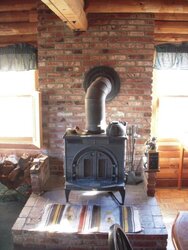Hello,
I just purchased an Englander 30NC, after much research on this site......thanks! I assumed that I had plenty of room for clearances and a large enough protected pad size, but the manual is confusing for me. I am hoping to get some help from the group.
As you see in the picture (with the old stove), there is a raised brick hearth that is 55" wide and is 53" deep. The back wall is fully protected with brick. On the other side of that brick is a combustible wall made from logs. The pipe vents through the wall and then turns 90 degrees upward continuing to above the second story of the cabin.
Here is what I don't understand:
The manual states I need floor protection of a minimum of 39" wide and 52.5" deep. I am good there.
It is the "clearance to combustibles" table that I don't understand. This table is broken into "unprotected" and "protected" surfaces. Would I use the "unprotected" or the "protected" clearances? Or, since there is a brick lining the back wall, can I get the stove as close as I want to that surface?
Also, all of the diagrams in the manual show the stove pipe (as it exits the top of the stove) must be 16" away from the back wall. Does this apply in my situation as well?
I am very new to all of this. Hopefully, this question makes sense.
Thanks in advance!
Bill
I just purchased an Englander 30NC, after much research on this site......thanks! I assumed that I had plenty of room for clearances and a large enough protected pad size, but the manual is confusing for me. I am hoping to get some help from the group.
As you see in the picture (with the old stove), there is a raised brick hearth that is 55" wide and is 53" deep. The back wall is fully protected with brick. On the other side of that brick is a combustible wall made from logs. The pipe vents through the wall and then turns 90 degrees upward continuing to above the second story of the cabin.
Here is what I don't understand:
The manual states I need floor protection of a minimum of 39" wide and 52.5" deep. I am good there.
It is the "clearance to combustibles" table that I don't understand. This table is broken into "unprotected" and "protected" surfaces. Would I use the "unprotected" or the "protected" clearances? Or, since there is a brick lining the back wall, can I get the stove as close as I want to that surface?
Also, all of the diagrams in the manual show the stove pipe (as it exits the top of the stove) must be 16" away from the back wall. Does this apply in my situation as well?
I am very new to all of this. Hopefully, this question makes sense.
Thanks in advance!
Bill


